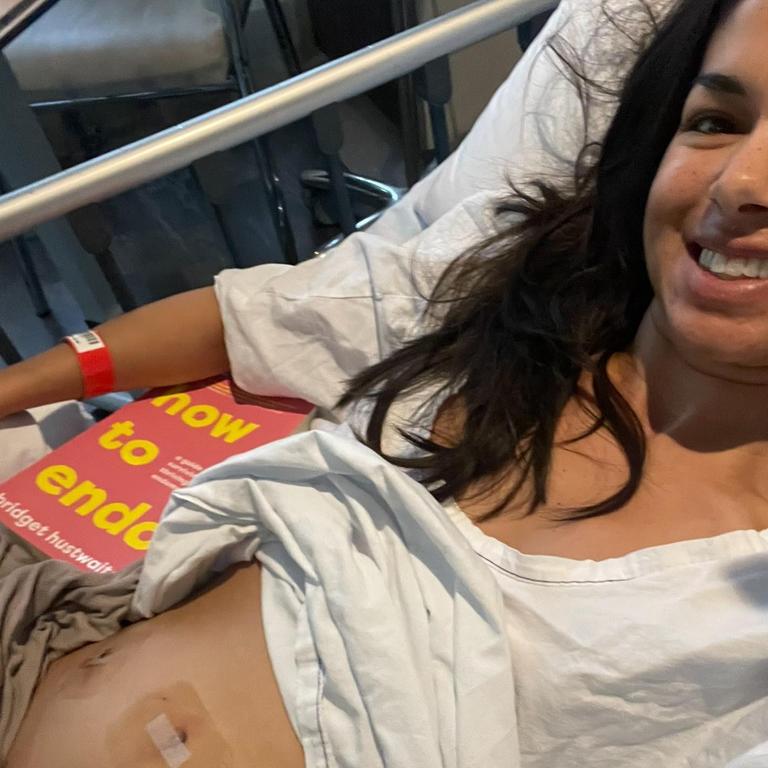Sarah Roberts’ fertility struggle uncovered her silent health battle
When Sarah Roberts struggled to conceive, doctors assured her it was “normal” – but the TV star pushed back, proving “something wasn’t right”.
When Sarah Roberts struggled to conceive, even with the help of fertility treatment, doctors assured her it was very common.
But after two miscarriages and five failed embryo transfers, the former Home and Away actress couldn’t fight the feeling it was something more sinister.
“I just knew in my gut that something was wrong, something in my body wasn’t right,” the 39-year-old told news.com.au.
“IVF can be difficult for a lot of people, but I had five genetically-tested embryos, and none of them stuck.
“And I remember, before I transferred the last one, I said to the specialist, ‘there’s something wrong with my body, it doesn’t feel normal to me.’
“It felt like someone had a really sharp knife covered in barbed wire and was stabbing me in the vagina. My insides were in agony.”
Medicare is failing women and it’s About Bloody Time things changed. Around one million suffer from endometriosis. There is no cure. Help is hard to come by and in rural or regional areas, it’s virtually impossible. We are campaigning for longer, Medicare-funded consultations for endometriosis diagnosis and treatment. Read more about the campaign and sign the petition here

The awful pain wasn’t Roberts’ only troubling symptom. She also had unexplained bloating, which became particularly bad during the egg collection stage of her IVF treatment, and had trouble going to the toilet.
But to her surprise, doctors didn’t seem too concerned by her worrying list of ailments.
Undeterred, and after reading about endometriosis – a condition that can affect fertility and cause an array of agonising issues in women – Roberts pushed for a laparoscopy.
A laparoscopy is a keyhole surgical procedure used to diagnose and treat endometriosis by checking for abnormal deposits of endometrial tissue, scarring or cysts in the reproductive organs and pelvis, and if necessary, removing this tissue.
“I went back to the IVF specialists and said, ‘I don’t care what anyone thinks, I want the surgery,” she explained.
“It was a huge risk because there is the potential I could go into the laparoscopy and find nothing. Then I would feel embarrassed and that everyone else had been right.
“I was terrified people would think I was just being hysterical.”

But she was far from wrong.
In fact, the procedure proved the popular personality – who also works as a DJ – was spot-on with her suspicions.
“They discovered I had stage two endometriosis and it was on the uterus, both of my ovaries and bowels,” she says.
“I replied and said, ‘yeah, I told you that six months ago.’
“It was such a funny feeling.
“On one side, I was so relieved because it was confirmation that I’m not crazy.
“But I was angry too because I honestly felt gaslit.”
Roberts is not alone in feeling this way. In a news.com.au survey of more than 1700 Australian women who suffer from endometriosis, 54.4 per cent said they had not been taken seriously by doctors and had mostly negative experiences, with 17.3 per cent saying they felt they had never been taken seriously when seeking medical help for endometriosis.
Despite the conflicting emotions around her diagnosis, Roberts says she felt grateful she finally knew she had endometriosis, a common condition that affects one in nine Australian women.

Endometriosis occurs when endometrial tissue, which is similar to that which lines the uterus, grows outside of the uterus – usually in areas like the ovaries and fallopian tubes as well as on organs such as the bladder, bowel, vagina and cervix.
In several extreme cases, it has even been found in the lungs and brain.
Symptoms and severity varies from person to person, but for many it can lead to crippling physical pain.
About one in three women who have endometriosis struggle with fertility and find it difficult to get pregnant.
“Even though doctors tell you that miscarriage and fertility issues are very common, it doesn’t help with the pain of what comes with losing a pregnancy,” Roberts explained.
“For a long time during my journey, I never tested for endometriosis, I’d never heard of it actually.
“It was only after I picked up bits and pieces of information on it that I really considered it might be the cause of my struggles.”

After her diagnosis, Roberts buried herself in research in a bid to understand her diagnosis and the symptoms that affect her on a daily basis.
“At first I was in disbelief, I was convinced there must be a way to fix it,” she says.
“I couldn’t accept that it was actually a chronic illness.
“I would read books and listen to podcasts and Google things and, you know, change my diet.
“With every kind of symptom that I got, I was like, oh, no, I better work on that, or there must be a way out of this.
“But it just got so tiring, it took up so much energy and it was exhausting for me.”
These days, Roberts says she has learned to “ride the waves”, admitting that sometimes she will “wash in and out of acceptance and grief”.
“It’s like grieving for the body that I once had, but also accepting that my body has just changed now, and that endometriosis has almost become, this might sound weird, but like my friend,” she says.
“But it’s a friend that you don’t really want to have.”

Although she frequently experiences symptoms, “it’s different every month” says Roberts, explaining that she’s noticed lifestyle factors can cause the condition to flare.
“Stress really impacts me, so I try to do things that are calming like yoga,” she shares.
“Also DJing has me standing for long periods of time and because of that my back gets really sore and then I get that stabbing pain again, but I just have a lot of drugs in my DJ bag, and not the fun kind, you know, just Panadol and Ibuprofen.
“I’ve also noticed if I eat certain things, drink less alcohol, stay off dairy and gluten, it really helps me but also, it’s really boring.
“So I also give myself breaks as well. Sometimes, I just want to have a good time and, you know, go out to a restaurant and not worry.”
Roberts bravely opened up on social media about her condition, finding support and connection with other women who share similar experiences.
“I think I’ve just about come to terms with it now, but it’s still really hard,” the star shared.
“Every single day I have endo belly and as the day progresses, I start to look like I’m pregnant.
“Sometimes, I just pretend that I am pregnant and let it sit there. Or I wear different clothes. I used to wear a lot of tight clothes and I still do at times, but if I’m going out at night for dinner I’ll probably wear something that drops at the waist.”
As for her plans of having a family, she has decided to “put that on ice…literally” for now, but says she is open to exploring other avenues to becoming a parent.
“I just want other women to hear my story and feel inspired and to trust their instincts, there is power in sharing” she added.
“Don’t be afraid to ask questions and push for answers. That’s what I wish someone had told younger Sarah.”
About Bloody Time is an editorial campaign by news.com.au that been developed in collaboration with scientists recommended by the Australian Science Media Centre, and with the support of a grant from the Walkley Foundation’s META Public Interest Journalism fund.
Read related topics:About Bloody Time







